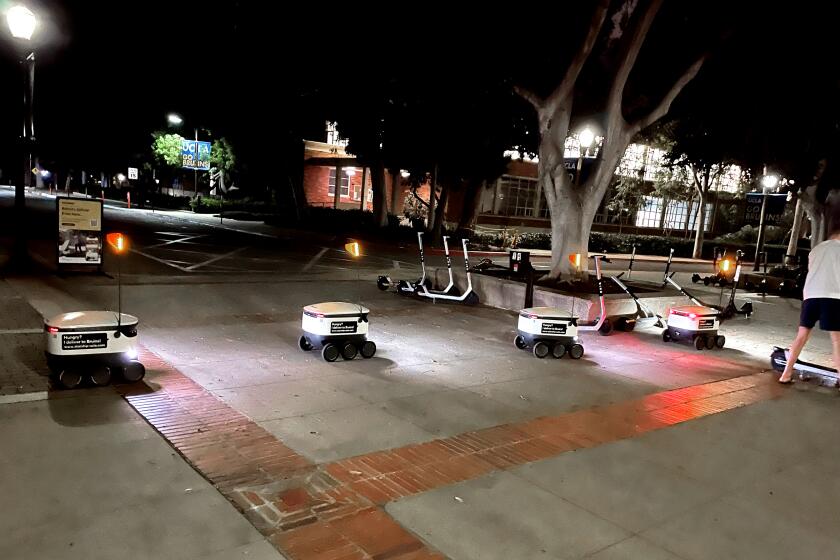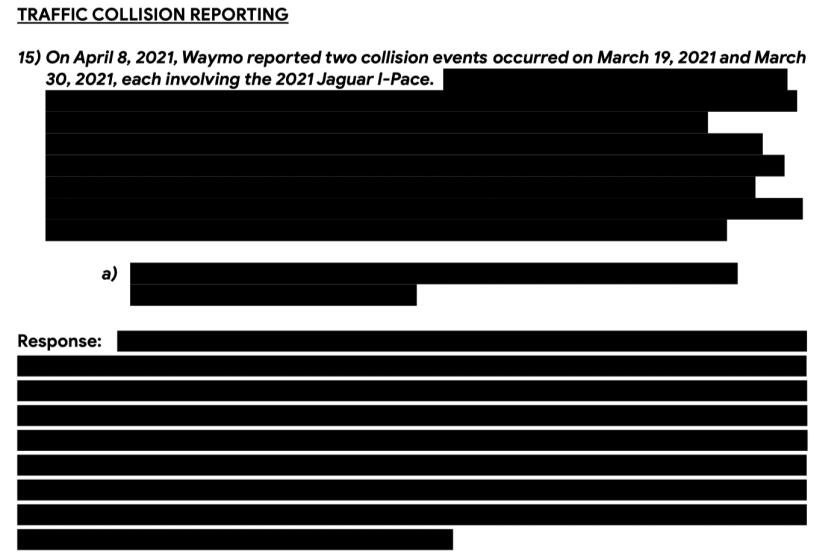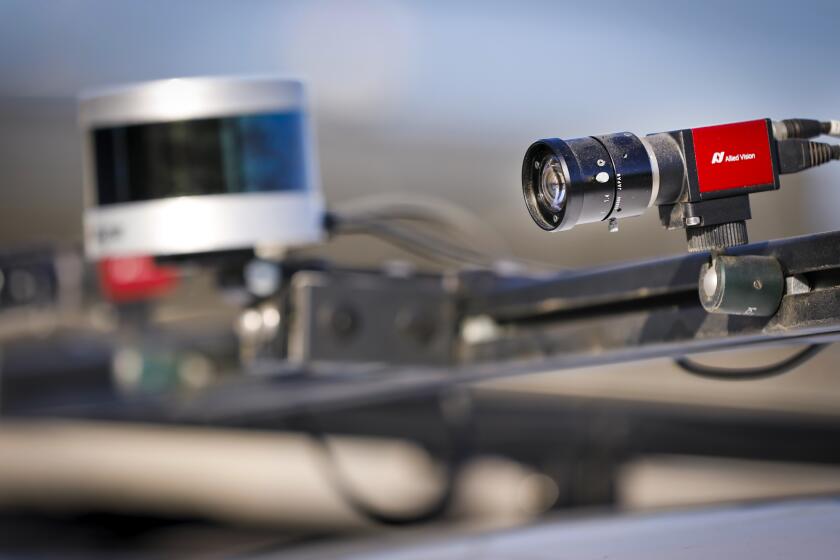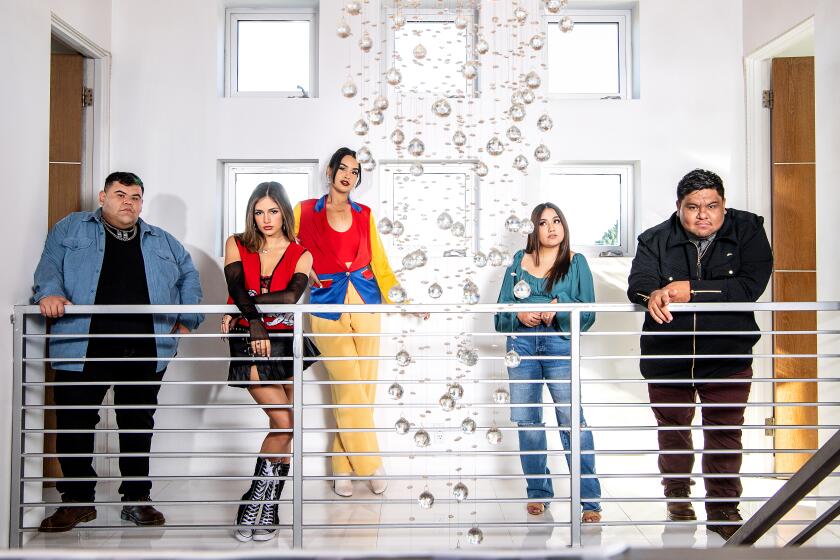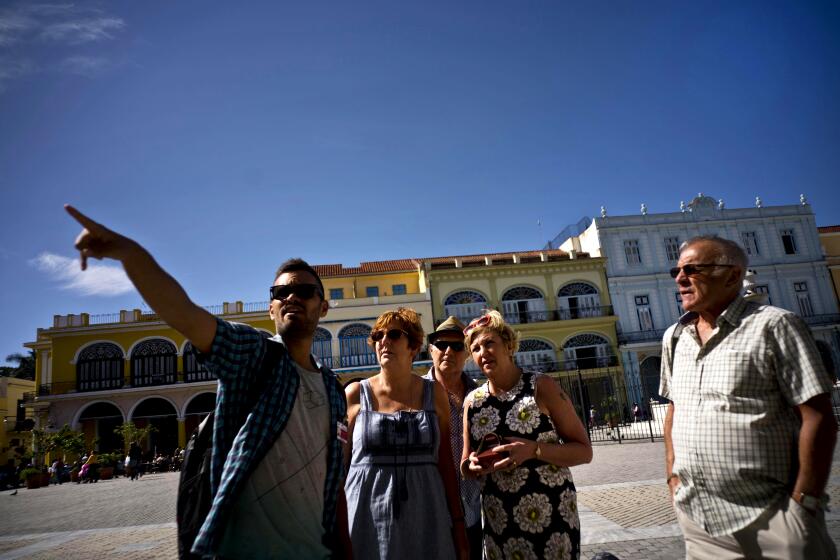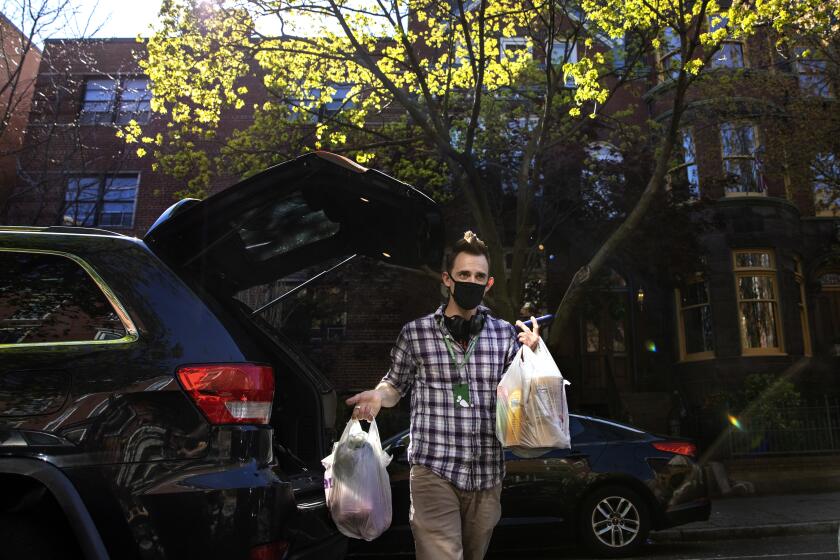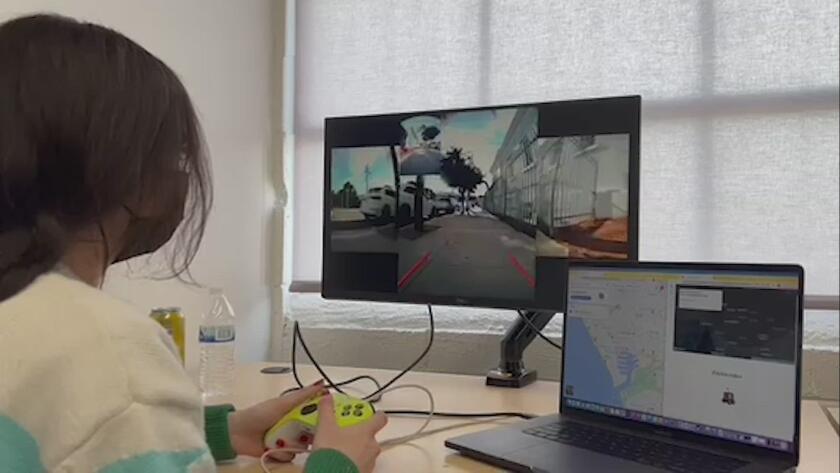Who’s driving that food delivery bot? It might be a Gen Z gamer
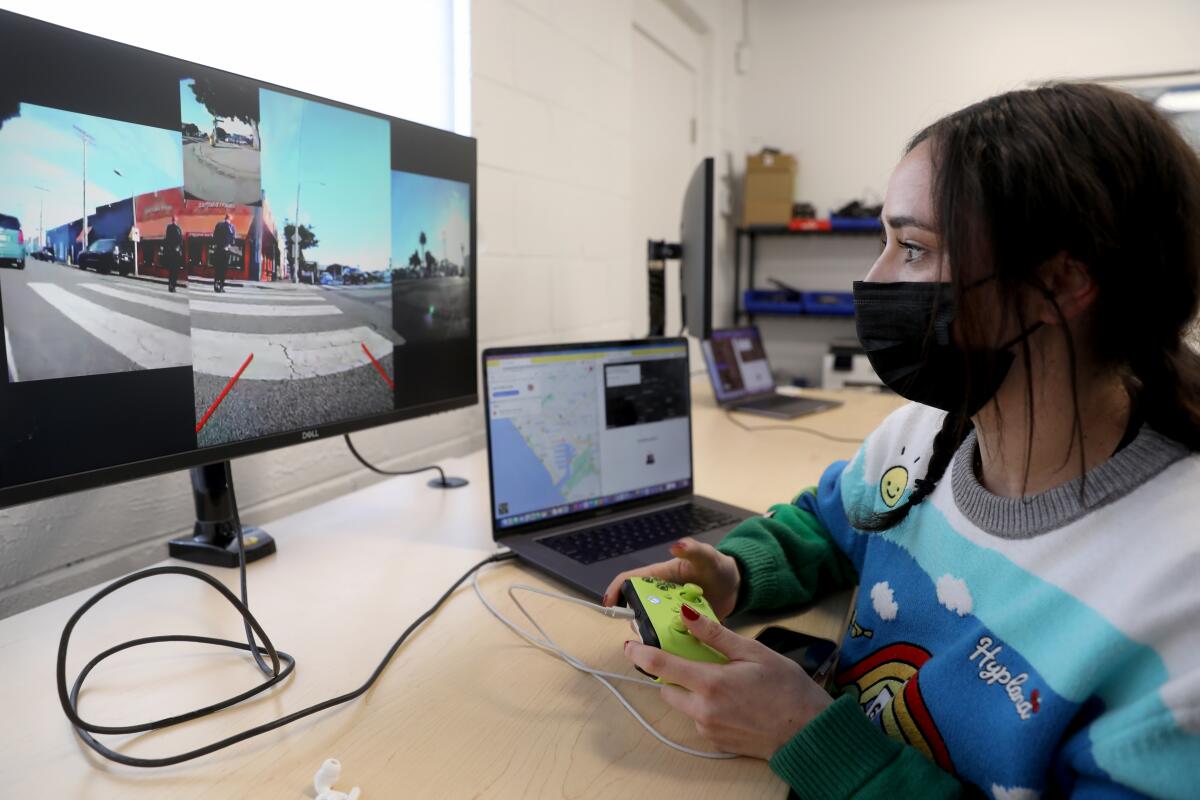
- Share via
In a low-light Culver City control room, Lily Shaw is getting her pilot mood on.
A can of mint Guayaki Yerba Mate sits near her carefully manicured fingers. “Good jams to get pumped” from alt rock band Slothrust blast on her earbuds. Horn-rimmed, blue-light filtering glasses protect her eyes. Her favored chartreuse Xbox controller stands ready to command her laptop.
Shaw is set for her mission: piloting an order of burritos and doughnuts along Santa Monica sidewalks to a hungry customer.
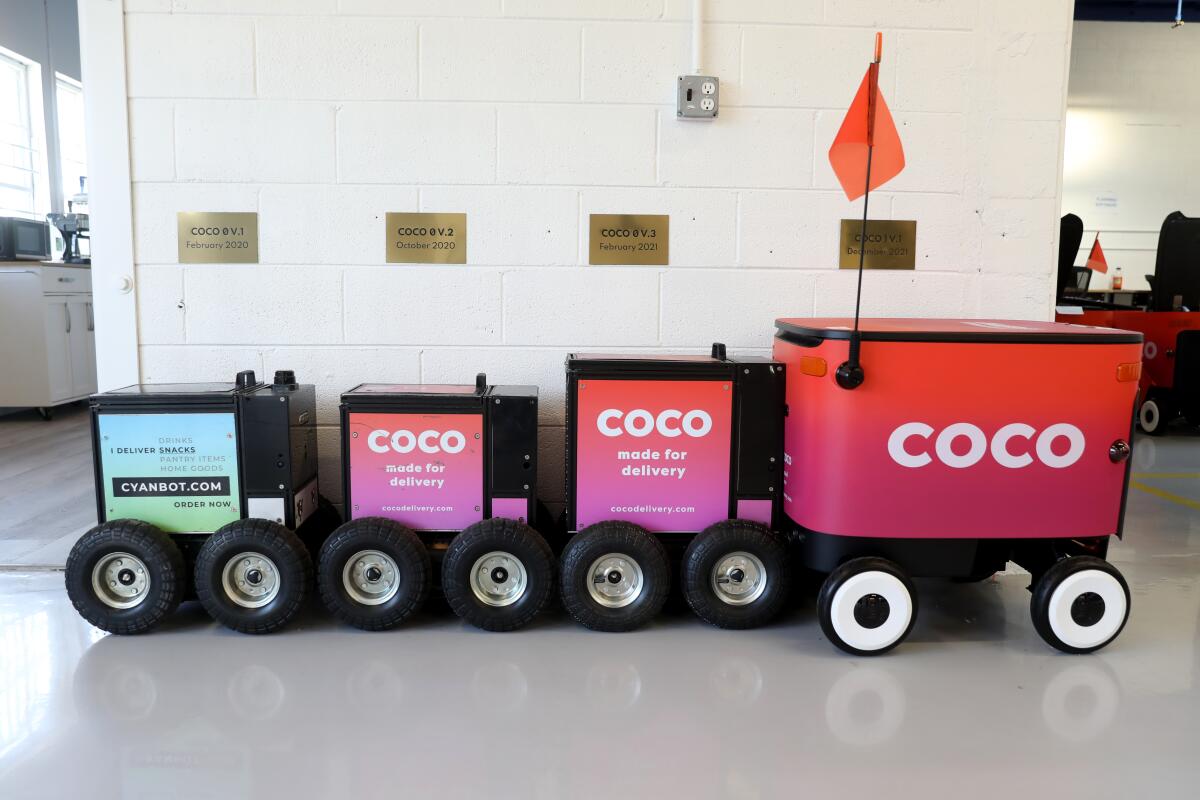
It’s not exactly “Top Gun,” but Shaw’s job at delivery startup Coco highlights a little-known fact about the autonomous delivery robot industry, which is projected to mushroom in growth over the next few years. Those cute sidewalk-traveling ice chests on wheels aren’t completely autonomous, unlike the Roomba roaming your house.
For all their AI and other advanced technology, such sidewalk robots — suddenly all over certain neighborhoods and college campuses — are backed by armies of human minders who track the last-mile delivery vehicles the way parents hover over toddlers taking their first steps. These behind-the-scenes workers monitor, drive, troubleshoot, rescue and — when things go terribly wrong — may hop on a bike or scooter to complete the delivery themselves.
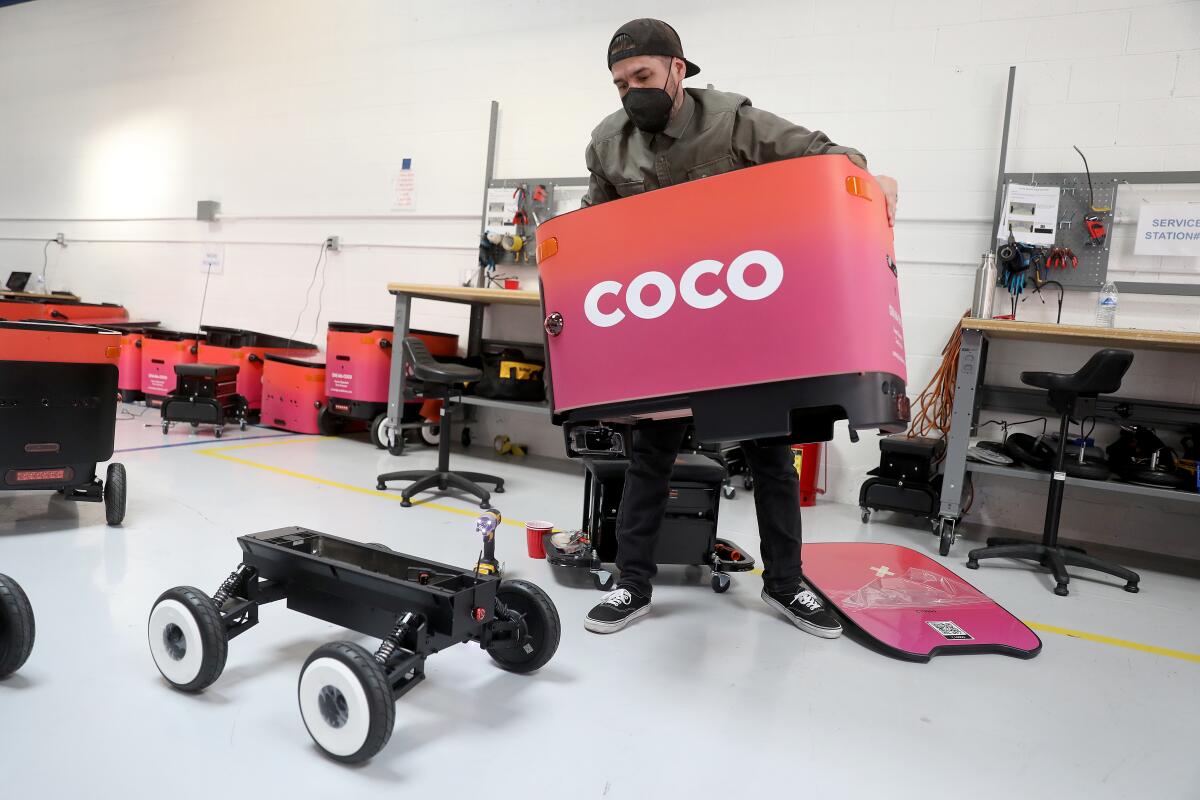
As sidewalk bots proliferate, they turn on the charm — flashing cute eyes, emoji hearts — to keep safe and get deliveries to their intended destinations.
California has become a proving ground for several sidewalk delivery robot startups like Coco, which was born two years ago in the living room of UCLA alumni Zach Rash and Brad Squicciarini, both now 24 and riding a pandemic-related desire for contact-free delivery. A recent partnership with Segway is promising to unleash thousands of the pink vehicles in multiple cities.
Another California startup, Kiwibot, also employs remote vehicle operators, while San Francisco-based Starship Technologies has designed its sidewalk delivery bots to mosey along on their own but with employees tracking every move via computer screen and grabbing control when needed.
This off-road race to compete with Uber Eats, DoorDash and other delivery companies that rely on gig workers is hindered by currently available self-driving technology, not to mention gaping sidewalk cracks. But it’s getting a big assist from the shortage of people willing to take gig-delivery work for the money offered.
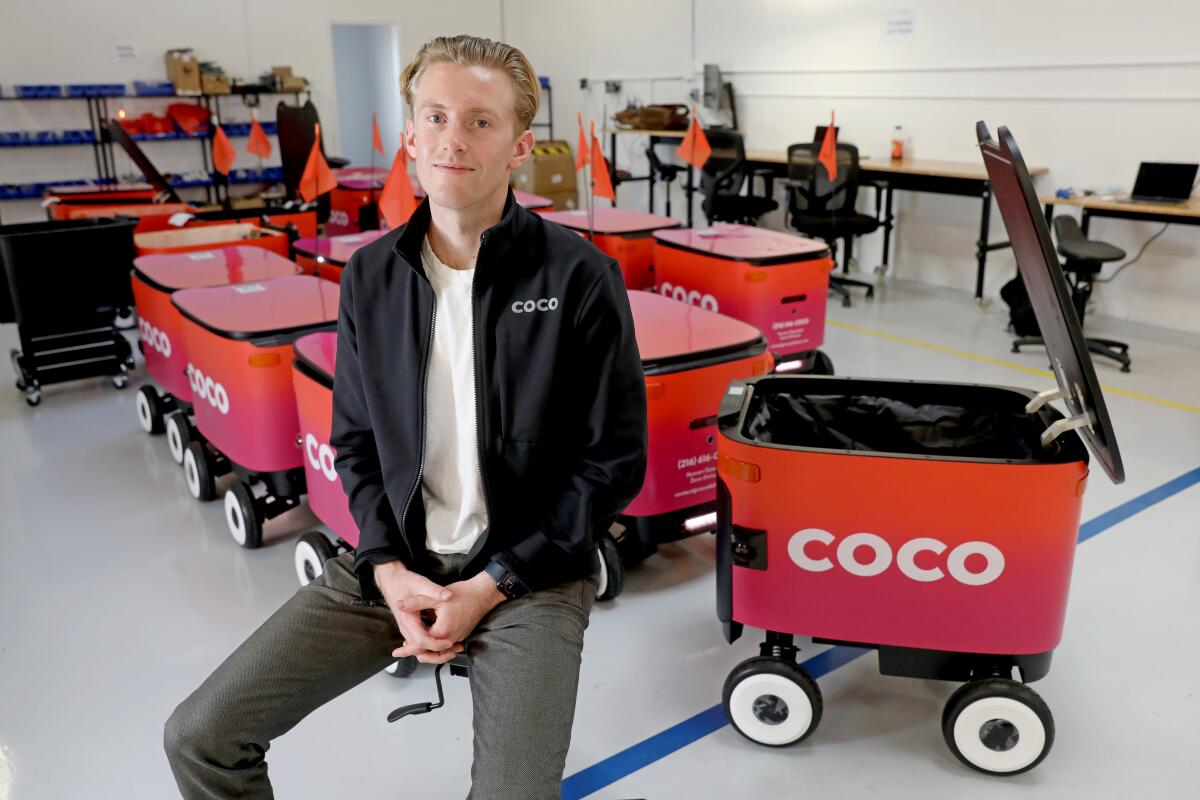
A court may decide whether Waymo’s business interests outweigh the public’s right to understand the safety issues around self-driving cars
“There’s a huge demand for delivery to people’s homes. Unfortunately there is a shortage of drivers for most types of delivery,” says Satyandra K. Gupta, director of USC’s Center for Advanced Manufacturing.
The demand for drivers “cannot be met at a cost that businesses are willing to pay. So the only option out of this is basically doing delivery by robots,” Gupta says.
Building a truly autonomous vehicle is definitely a work in progress.
The U.S. Department of Transportation has adopted a six-point standard for driving autonomy that applies to self-driving cars on public roads as well as 2-foot-tall delivery robots on sidewalks.
The scale starts at zero, where the vehicle must be human-controlled at all times, like Coco’s delivery bots. The scale tops out at level 5, where the vehicle drives itself and can go anywhere under all conditions. That’s what carmakers and Alphabet’s Waymo are striving for with self-driving passenger vehicles and freight delivery trucks.
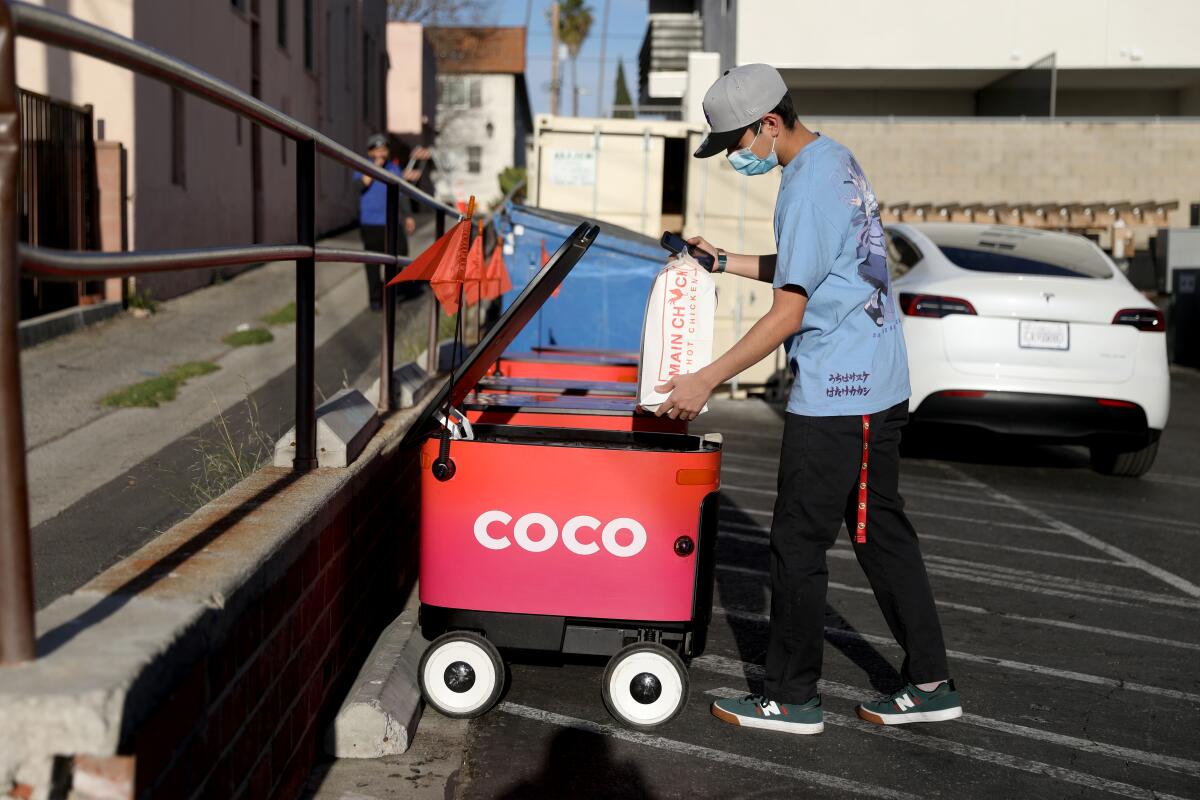
They collect user data for their own ends, but when it comes to allowing crash data to be used to improve safety, these companies push for less transparency.
Starship Technologies bots land at level 4. Chief Executive Alastair Westgarth says the robots can find their way along most routes and can even climb curbs. Human intervention comes into play only when the bot finds something it doesn’t expect or when mayhem ensues.
(Despite the internet’s collection of bots getting into hilarious trouble, the delivery companies all note that the low-mass, low-speed vehicles are designed with safety in mind and have operated without serious harm to people or property.)
“Say it finds a piece of construction equipment that wasn’t there before. It’s not on the maps. The robot doesn’t recognize it,” Westgarth says.
At first, the bot will assess the situation on its own.
“If it knows a way around that obstruction, even if it doesn’t know what the obstruction is, it will do that by itself,” Westgarth says. “If it cannot figure that out, it calls home.” A human, who had been watching the bot remotely, takes over.
Still, some obstacles take a long time to master. Trains, for instance. Starship‘s bots were completely flummoxed by things first blocking the way and then suddenly gone.
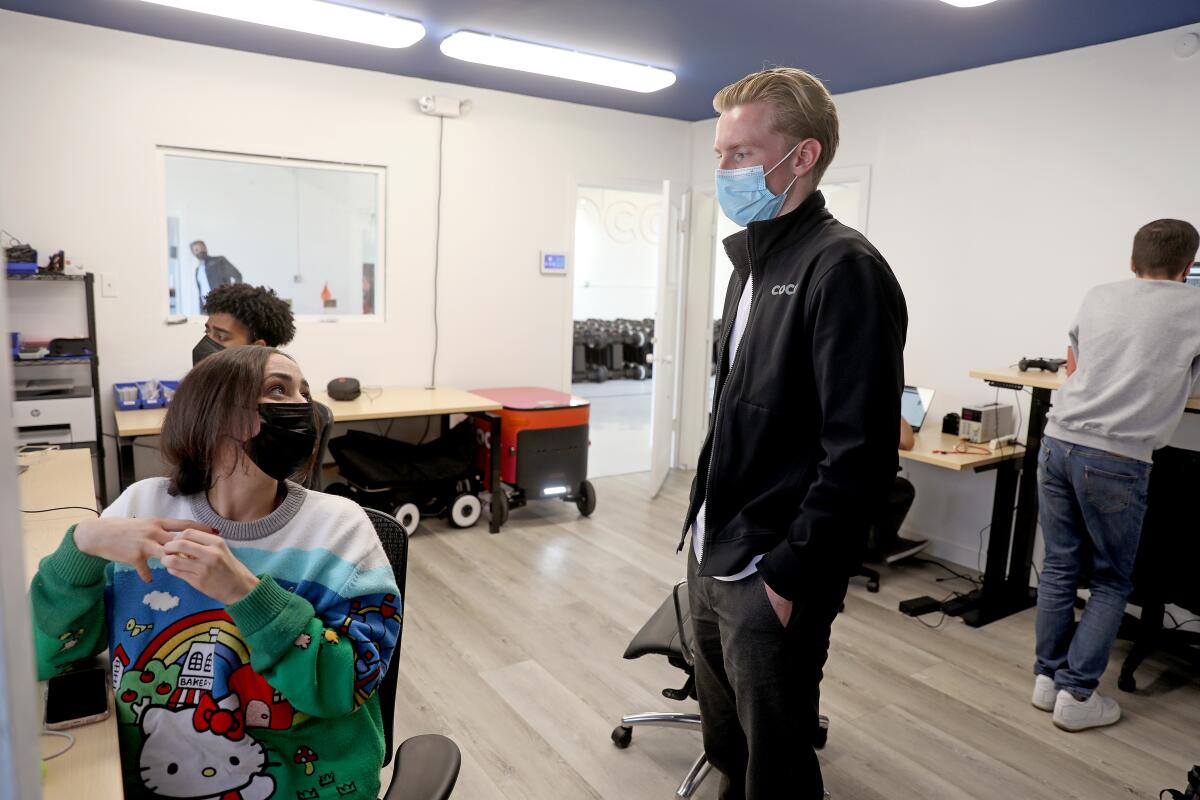
“A train could be half a mile long and to the robot, it looks like a wall,” Westgarth says.
“We had to figure out algorithms for the radar to give us a continuous velocity read, also allow us to identify the wheels. Then we could build the logic: It’s a train. You’re going to be waiting for a while. Wait for an indication that the train is gone, see if anything else is in the way and then, it can cross. The system learns.”
Each Starship bot comes equipped with six wheels, an AMD Ryzen processor, radar, cameras, lights, speakers that allow the bot to talk and an illuminated flag on a pole, which makes the vehicle more visible as it navigates across roads and among pedestrians. The bot voice and flag also help amplify the cute factor, like a cartoon character crossed with a grade-schooler’s souped-up bike.
Being adorable isn’t just a marketing tactic, it’s an integral part of the companies’ efforts to increase acceptance and ensure the little vehicles’ safety from human ire. Robot designers have added features that allow the vehicles to communicate with pedestrians using LED screens, pre-recorded messages and emoji-like eyes.
Online videos show robot rescuers having emotional reactions when Starship bots respond with a chipper “Thank you. Have a nice day!” People wave. Children follow them down the street.
Although the robots’ friendly appearance is what customers recall, their creation involves serious science.

In only a few years, the five young Latinos in the Familia Fuego TikTok collective have gone from working day jobs to mixing with Hollywood’s elite.
“You have a mixture of artists, engineers, operations people, businesspeople working in tandem, just so you can see a robot deliver a burrito, which I think is pretty fascinating,” says Kiwibot co-founder David Rodriguez, 28, who first tested the company’s remote piloting technology in 2017 at the UC Berkeley Sky Deck Acceleration Program using a Hot Wheels-size vehicle.
Although sidewalk delivery was boosted by pandemic lockdown orders, the businesses like to highlight how bots help reduce pollution and climate change.
Rash and his Coco co-founder are avid surfers who, tired of all the trash they’d see on the water, wanted to do something that might help the environment.
“It was a little depressing to think that the future was going to involve 4,000-pound, 3,000-pound cars driving in circles a couple blocks all day, every day just to deliver food,” Rash says.
Back at Coco’s Culver City office, Lily Shaw is piloting a delivery from Alfalfa, a Santa Monica restaurant. Co-owner Dan Londono says he was attracted by the time savings.
“One of the key benefits is speed, as we are able to send the food out to our nearby customers in the Coco robots as soon as the order is ready and not wait for drivers to arrive,” he says.
Despite the pandemic’s Great Resignation and resulting worker shortage, Coco has managed to create enthusiasm within a largely untapped workforce: Generation Z. The company’s young squadron of about 150 pilots — dubbed “Coconauts” — offers something parents around the world have told their teens not to expect in real life: a paying job with “experience playing racing video games” listed as a requirement.
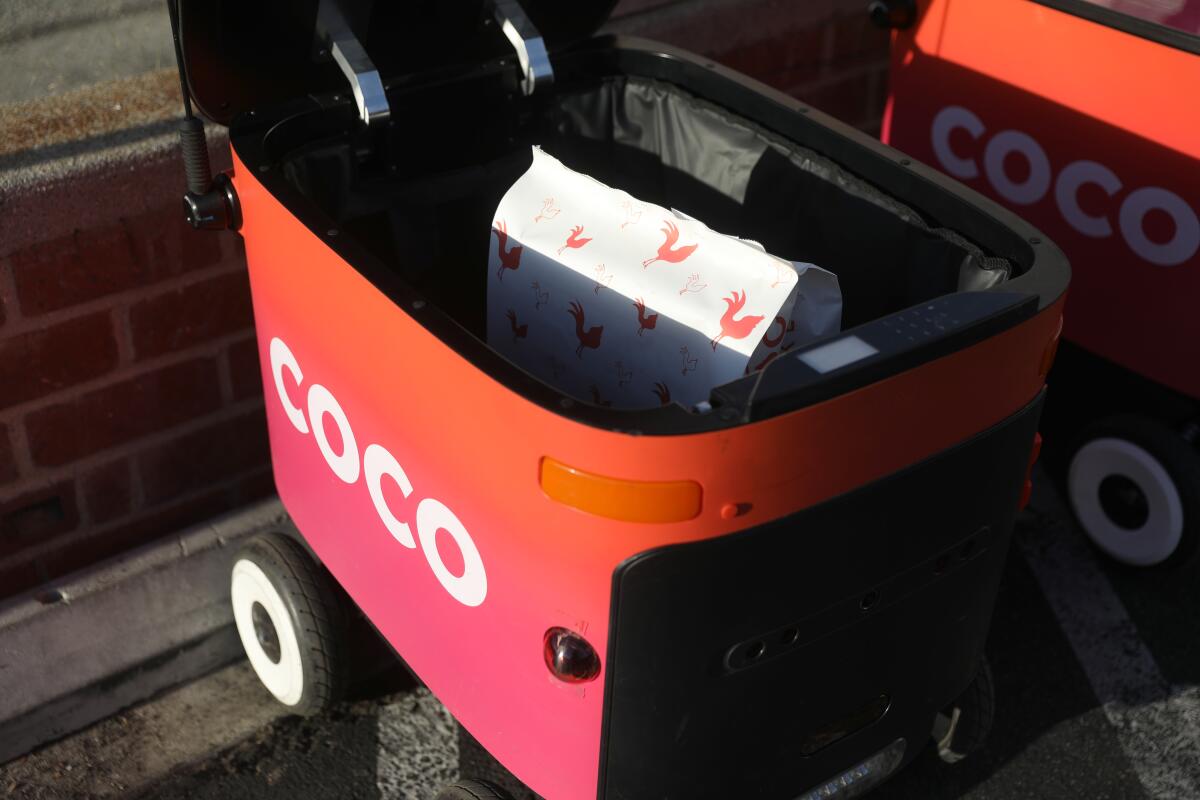
Any remote job can be adapted to a nomadic existence. But these careers will allow you to free yourself from both the office and a boss’s schedule.
“As a Coconaut, you’ll join an elite team: the pilots of our remotely-operated robot fleet,” Coco’s standard pilot job listing says. “Once you’ve completed a brief training, you can enter your virtual robot cockpit, accept jobs, and deliver items to our customers. Get paid to drive robots!”
But there’s a catch. Leave your urban mayhem Grand Theft Auto techniques at the door. Coconauts must drive their robots “carefully and responsibly.”
Coco’s remote pilots earn more than U.S. minimum wage, Rash says, declining to be more specific.
Kiwibot’s drivers might work in foreign countries, earning less than U.S. minimum wage. That ignited a brief controversy at UC Berkeley, the Daily Californian reported in 2019, because students were concerned Kiwibot pilots in Colombia were earning the equivalent of $2 an hour, which a company representative said was higher than Colombia’s minimum wage.
One trick to piloting is getting used to the viewpoint — about the height of a small dog. Shaw’s four video cameras show humans as giants and bigger canines as hippo-size. People rushing past look as if they are going to run right over the bot. Sidewalk signs appear as tank barricades. Swinging doors look like a glass building is suddenly coming at you.
“I’ve driven through worse,” shrugs Shaw, untroubled, except, maybe, for those doors. “Someone will open them just as I’m passing by and they could get me,” she says, speaking as if she were the bot. “You’ve got to be careful.”
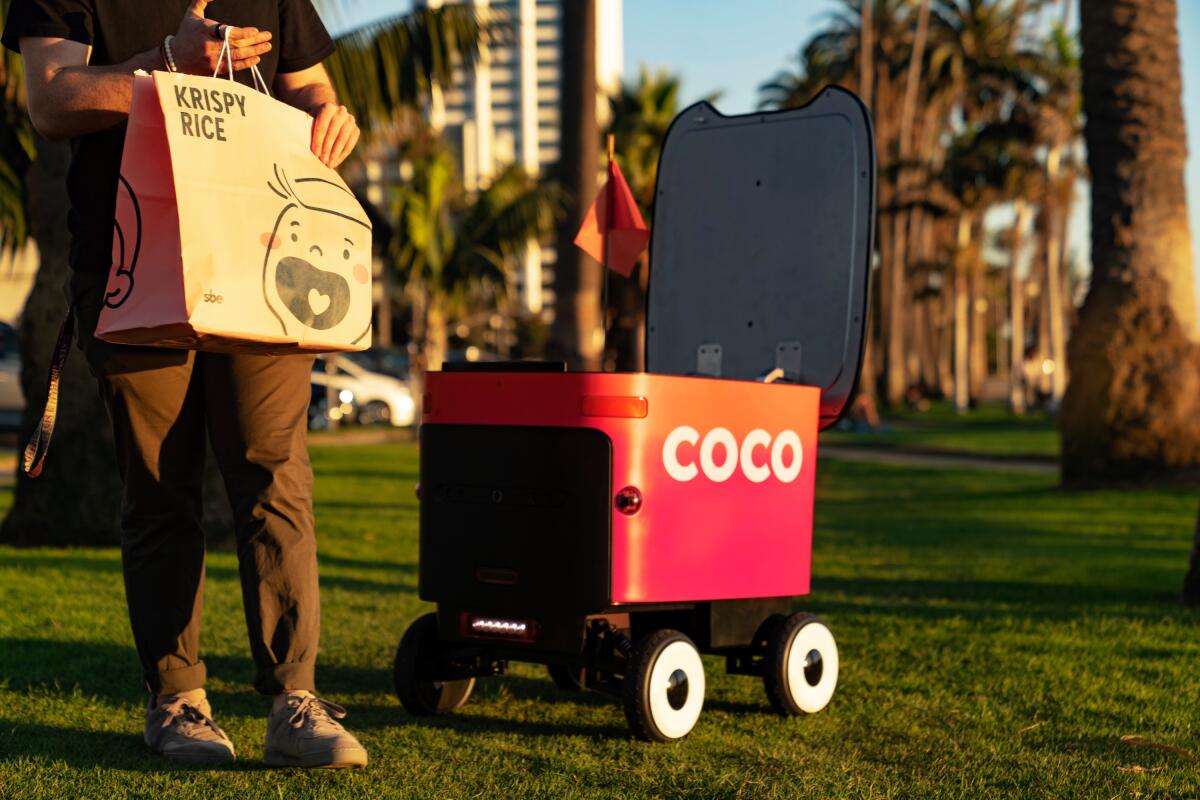
The best driving gigs in any given city can pay almost twice as much as the most poorly paid. Before diving in, you’ll want to know which are which.
Before they start piloting, Coco workers receive 30 hours of paid training, something that was essential for Shaw, who is one of the few pilots without a console gaming background. She was a little nervous at first but began playing video games in her off hours “and when I did that, I noticed that I was definitely becoming more skilled at piloting bots.”
Most of the other pilots are like Cole Green, 21, a gamer who rivals Tom Brady for sport longevity. Green, who is studying sociology at Santa Monica College, has been playing on XBox since he was 7. In effect, he’s had an apprenticeship for bot controlling that has lasted two-thirds of his life.
“The gaming made it much easier for me, I already knew about how to handle lags in the timing and how to react and what to do,” Green says. “The gaming is definitely harder than piloting the bots.”
Coco pilot trainer Max Lopez drills in the basics: “Always stop at driveways. Always defer to pedestrians. If there is a crowd approaching, just back off to the side and let them pass. And be prepared when children and dogs take a keen interest in the bot.”
Sometimes, it’s more than a keen interest.
- Share via
Lily Shaw, one of Coco’s pilots, shows how an autonomous robot can get around the streets of Santa Monica.
“The biggest obstructions are people trying to take selfies with the bots,” says Carl Hansen, Coco’s vice president of government relations.
YouTube brims with videos of people trying to prank or harm bots. One shows kids on scooters zooming ahead of a bot and laying down the scooters in its path, just to see the bot maneuver around the obstacle.
“I’ve had that happen to me,” Shaw says, doing the bot meld thing again.
Shaw likes that it’s a job she is allowed to do from anywhere. The pay is enough to be comfortable, especially for a student.
“That’s really nice,” she says. “My parents are thrilled that I’m earning money doing this.”
More to Read
Inside the business of entertainment
The Wide Shot brings you news, analysis and insights on everything from streaming wars to production — and what it all means for the future.
You may occasionally receive promotional content from the Los Angeles Times.
